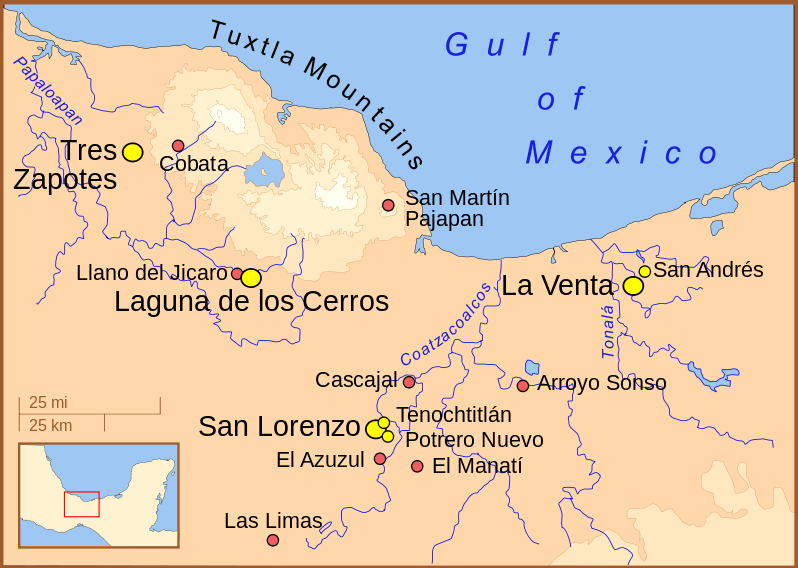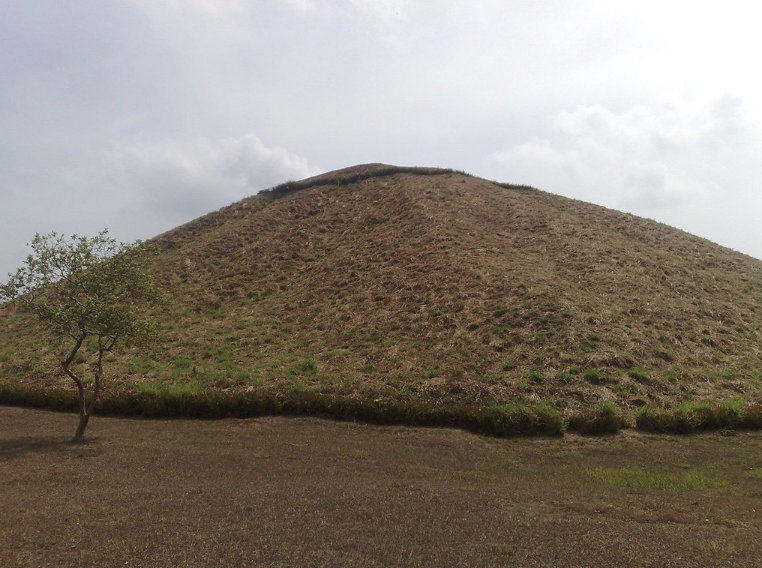The Olmecs
Mask, 10th–6th century B.C.
Mexico; Olmec
Jadeite; Overall: 6 3/4 x 6 5/16 x 6 5/16 in. (17.1 x 16 x 16 cm)
The Metropolitan Museum of Art, New York
Source: Wikipedia.
1- Who were the Olmecs?
The Olmecs were the first major civilization in Mexico. They lived in the tropical lowlands on the Gulf of Mexico in the present-day Mexican states of Veracruz and Tabasco. The name Olmec is a Nahuatl—the Aztec language—word; it means the "rubber people". The Olmecs might have been the first people to figure out how to convert latex of the rubber tree into something that could be shaped, cured, and hardened. Because the Olmecs did not have much writing beyond a handful of carved glyphs—symbols—that survived, we don't know what name the Olmec people gave themselves.
Appearing around 1600 BCE, the Olmecs were among the first Mesoamerican complex societies, and their culture influenced many later civilizations, like the Maya. The Olmecs are known for the immense stone heads they carved from a volcanic rock called basalt. Archaeological evidence also suggests that they originated the Mesoamerican practices of the Mesoamerican Ballgame—a popular game in the pre-Columbian Americas played with balls made from solid rubber—and that they may have practiced ritual bloodletting.
2- Trade and village life:
A map of the Olmec heartland. The yellow dots represent Olmec settlements, and the red dots represent archaeological finds. These Spanish place names are modern; we don't know what the Olmec names for these places were. Image courtesy: Wikimedia Commons.
There are no written records of Olmec commerce, beliefs, or customs, but from the archaeological evidence, it appears they were not economically confined. In fact, Olmec artifacts have been found across Mesoamerica, indicating that there were extensive inter-regional trade routes. The presence of artifacts made from jade, a semiprecious green stone; obsidian, a glassy, black volcanic rock; and other stones provides evidence for trade with peoples outside the Gulf Coast of Mexico: the jade came from what is today the Mexican state of Oaxaca and the country of Guatemala to the south; the obsidian came from the Mexican highlands, to the north. The Olmec period saw a significant increase in the length of trade routes, the variety of goods, and the sources of traded items.
Trading helped the Olmecs build their urban centers of San Lorenzo and La Venta. These cities, however, were used predominantly for ceremonial purposes and elite activity; most people lived in small villages. Individual homes had a lean-to—sort of like a garage shed—and a storage pit for storing root vegetables nearby. They also likely had gardens in which the Olmecs would grow medicinal herbs and small crops, like sunflowers. Most agriculture took place outside of the villages in fields cleared using slash-and-burn techniques. The Olmecs likely grew crops such as maize, beans, squash, manioc, sweet potatoes, and cotton.
Great Pyramid in La Venta, Tabasco. Image courtesy: Boundles.
3- Religion:
A photo of La Venta Stela 19, the earliest known representation of the Feathered Serpent in Mesoamerica.
Source: Audrey and George Delange- Wikipedia.
There are no direct written accounts of Olmec beliefs, but their notable artwork provide clues about their life and religion.
There were eight different androgynous—possessing male and female characteristics—Olmec deities, each with its own distinct characteristics. For example, the Bird Monster was depicted as a harpy eagle associated with ruler-ship. The Olmec Dragon was shown with flame eyebrows, a bulbous nose, and bifurcated tongue. Deities often represented a natural element and included the following:
- The Maize deity
- The Rain Spirit or Were-Jaguar
- The Fish or Shark Monster
Religious activities regarding these deities probably included the elite rulers, shamans, and possibly a priest class making offerings at religious sites in La Venta and San Lorenzo.
4- Art:
Anthropomorphic plaque, possibly the Fire Sepent, possibly a forgery, Olmec, Formative period, 800-400 BC, serpentine, cinnabar - Dallas Museum of Art.
Source: Daderot- Wikipedia.
The Olmec culture was defined and unified by a specific art style. Crafted in a variety of materials—jade, clay, basalt, and green-stone, which is an archaeologist's term for carved, green-colored minerals—much Olmec art is naturalistic. Other art expresses fantastic anthropomorphic—human-shaped—creatures, often highly stylized, using an iconography reflective of a religious meaning. Common motifs include down-turned mouths and cleft heads, both of which are seen in representations of were-jaguars and the rain deity.
"Baby" Figure, 12th–9th century B.C.E.
Mexico; Olmec
Ceramic, cinnabar, red ochre; H x W x D: 13 3/8 x 12 1/2 x 5 3/4in. (34 x 31.8 x 14.6cm)
The Metropolitan Museum of Art, New York.
Source: Wikipedia.
5- Olmec Writing system:
Statuette of Tuxtla with Epi-Olmec script glyphs.
Source: Adrian Hernandez- Wikipedia.
The Olmecs may have been the first civilization in the Western Hemisphere to develop a writing system. Symbols found in 2002 and 2006 date from 650 BCE and 900 BCE respectively, preceding the oldest Zapotec writing found so far, which dates from about 500 BCE.
The 2002 find at the San Andrés site shows a bird, speech scrolls, and glyphs that are similar to the later Mayan hieroglyphs. Known as the Cascajal Block, and dated between 1100 BCE and 900 BCE, the 2006 find from a site near San Lorenzo shows a set of 62 symbols, 28 of which are unique, carved on a serpentine block. A large number of prominent archaeologists have hailed this find as the "earliest pre-Columbian writing". Others are skeptical because of the stone's singularity, the fact that it had been removed from any archaeological context, and because it bears no apparent resemblance to any other Mesoamerican writing system.
There are also well-documented later hieroglyphs known as "Epi-Olmec", and while there are some who believe that Epi-Olmec may represent a transitional script between an earlier Olmec writing system and Mayan writing, the matter remains unsettled.
6- Olmec colossal heads:
Olmec Head San Lorenzo No. 1, sculpted around 1200-900 BCE
Source: Mesoamerican- Wikipedia.
The most striking art left behind by this culture are the Olmec colossal—very big—heads. Seventeen monumental stone representations of human heads sculpted from large basalt boulders have been unearthed in the region to date. The heads date from at least before 900 BCE and are a distinctive feature of the Olmec civilization. All portray mature men with fleshy cheeks, flat noses, and slightly crossed eyes. However, none of the heads are alike, and each boasts a unique headdress, which suggests they represent specific individuals.
Colosal head at Xalapa Museum.
Source: Wikipedia.
The Olmecs brought these boulders from the Sierra de los Tuxtlas mountains of Veracruz. Given that the extremely large slabs of stone used in their production were transported over large distances, requiring a great deal of human effort and resources, it is thought that the monuments represent portraits of powerful individual Olmec rulers, perhaps carved to commemorate their deaths. The heads were arranged in either lines or groups at major Olmec centers, but the method and logistics used to transport the stone to the sites remain uncertain.
7- The end of the Olmecs:
The Olmec population declined sharply between 400 and 350 BCE, though it is unclear why. Archaeologists speculate that the depopulation was caused by environmental changes, specifically by the silting-up of rivers, which choked off the water supply.
Another theory for the considerable population drop proposes relocation of settlements due to increased volcanic activity as the cause rather than extinction. Volcanic eruptions during the Early, Late, and Terminal Formative periods would have blanketed the lands with ash and forced the Olmecs to move their settlements.
Olmec tomb at La Venta Park, Villahermosa, Mexico. Source: Jetovar- Wikipedia.
* Documentaries:
Lost Kingdoms of Central America: Kingdom of the Jaguar: The.Olmecs- BBC-2014
Olmec Civilization: A great indigenous American Civilization
* Sources:
- - Pohl, Mary; Kevin O. Pope; Christopher von Nagy (2002). "Olmec Origins of Mesoamerican Writing". Science. 298 (5600): 1984–1987.
- - "Writing May Be Oldest in Western Hemisphere". New York Times. 15 September 2006. Retrieved 2008-03-30.
A stone slab bearing 3,000-year-old writing previously unknown to scholars has been found in the Mexican state of Veracruz, and archaeologists say it is an example of the oldest script ever discovered in the Americas.
- "'Oldest' New World writing found". BBC. 14 September 2006. Retrieved 2008-03-30.
Ancient civilizations in Mexico developed a writing system as early as 900 BC, new evidence suggests.
- "Oldest Writing in the New World". Science. Retrieved 2008-03-30.
- - Khan Academy.
- -www.wikipedia.org



.jpg)






Comments
Post a Comment